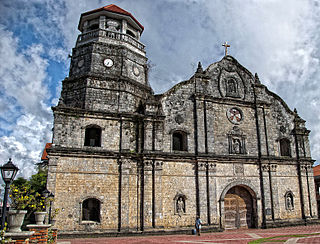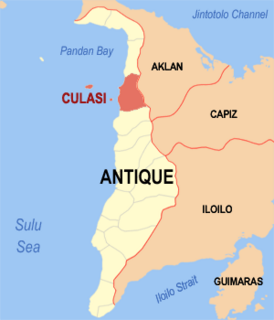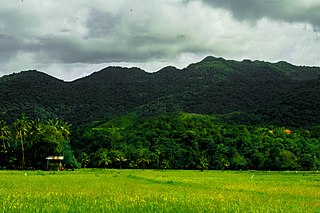
Panay is the sixth-largest and fourth-most populous island in the Philippines, with a total land area of 12,011 km2 (4,637 sq mi) and has a total population of 4,542,926 as of 2020 census. Panay comprises 4.4 percent of the entire population of the country. The City of Iloilo is its largest settlement with a total population of 457,626 inhabitants as of 2020 census.

Aklan, officially the Province of Aklan, is a province in the Western Visayas region of the Philippines. Its capital is Kalibo. The province is situated in the northwest portion of Panay Island, bordering Antique to the southwest, and Capiz to the east. Aklan faces the Sibuyan Sea and Romblon province to the north.

Capiz, officially the Province of Capiz, is a province in the Philippines located in the central section of Western Visayas region. Its capital is the city of Roxas. It is located at the northeastern portion of Panay Island, bordering Aklan to the north, Antique to the west, and Iloilo to the south. Capiz faces the Sibuyan Sea to the north.

Malinao was located in phili officially the Municipality of Malinao, is a 4th class municipality in the province of Aklan, Philippines. According to the 2020 census, it has a population of 24,517 people.

Kalibo, officially the Municipality of Kalibo, is a 1st class municipality and capital of the Province of Aklan, Philippines. According to the 2020 census, it has a population of 89,127 people.

Banga, officially the Municipality of Banga, is a 3rd class municipality in the province of Aklan, Philippines. According to the 2020 census, it has a population of 40,318 people.

Libacao, officially the Municipality of Libacao, is a 3rd class municipality in the province of Aklan, Philippines. According to the 2020 census, it has a population of 28,272 people.

Madalag, officially the Municipality of Madalag, is a 4th class municipality in the province of Aklan, Philippines. It is Aklan's largest municipality by land area and also the most sparsely populated. According to the 2020 census, it has a population of 18,890 people.

Nabas, officially the Municipality of Nabas, is a 4th class municipality in the province of Aklan, Philippines. Nabas serves as the arrival gateway of Boracay Airport. According to the 2020 census, it has a population of 40,632 people, making it the fifth most populous town in Aklan Province. .

Culasi, officially the Municipality of Culasi, is a 3rd class municipality in the province of Antique, Philippines. According to the 2020 census, it has a population of 44,494 people. Making it fourth most populous municipality in the province of Antique and third largest municipality in terms of land area, with a total area of 228.56 square kilometers.

San Jose, officially the Municipality of San Jose, is a 5th class municipality in the province of Romblon, Philippines. According to the 2020 census, it has a population of 11,759 people.

The Panay River is the longest river on Panay Island in the Philippines, with a total length of approximately 152 kilometres (94 mi) and a drainage basin area of 2,203.76 square kilometres (850.88 sq mi). It drains almost the entire province of Capiz and northern portion of Iloilo province.
The legislative districts of Capiz are the representation of the province of Capiz in the various national legislatures of the Philippines. The province is currently represented in the lower house of the Congress of the Philippines through its first and second congressional districts.
The Aklanon people are the ethnolinguistic group who lived in the province of Aklan. They are part of the wider Bisaya ethnolinguistic group, who constitute the largest Filipino ethnolinguistic group.

Mount Madja-as is a large dormant volcano and the highest peak in the island of Panay, in the Philippines. It is the second highest mountain in the Visayas, after Mount Kanlaon on Negros Island. With an elevation of 6,946 feet above sea level, it is the 63rd-highest peak of an island on Earth and the 9th-most prominent mountain in the Philippines. The mountain is famous for its "sea of clouds" and for its diverse flora and fauna, mossy forest and 14 waterfalls down to its slopes.

Capiznon or Capiceño is an Austronesian regional language spoken in Western Visayas in the Philippines. Capiznon is concentrated in the province of Capiz in the northeast of Panay Island. It is a member of the Bisayan language family and the people are part of the wider Visayan ethnolinguistic group, who constitute the largest Filipino ethnolinguistic group. The language is often confused with Hiligaynon due to dialectological comprehension similarities and as high as 91% mutual intelligibility, but it has its certain unique accent and vocabulary that integrates Aklanon and Waray lexicon. Despite its distinct corruption of Hiligaynon lateral approximants, a prevalent feature among rural farmers, ethnic convergence and cosmopolitanism has led to a shift back to the purely Hiligaynon prosodic form of slower tonality and softer and longer vowels most particularly among the younger generations.
The Sibalom River is the longest river in the province of Antique in Panay island Philippines. With a total length of 73 kilometres (45 mi) and a drainage basin covering 682 square kilometres (263 sq mi), it is the largest river system in Antique and fourth longest in Panay after the Panay River, Jalaur River, and Aklan River. It is located in Sibalom and San Remigio. Along with its main tributaries the Mao-it River and Tipulu-an River, it forms the 5,511.47-hectare (13,619.1-acre) Tipulu-an and Mao-it River Watershed Forest Reserve which was proclaimed a natural park on 23 April 2000.

Central Panay Mountain Range is the longest and largest mountain range in the island of Panay and Western Visayas in the Philippines. With a total length of 170 km (110 mi) long north–south and 34 km (21 mi) width east–west. It is famous for its diverse flora and fauna, mossy forest, pristine river's, Waterfalls and clusters of Rice Terraces. Located through the western Panay, from vicinity of Ibajay, Aklan to the north to Anini-y, Antique southern tip to the south. Occupied almost the entire province of the eastern portions of Antique, western Iloilo, western Capiz and western Aklan.
Mount Nangtud is the second highest peak on the island of Panay, in the Philippines and third highest mountain in the Visayas, after Mount Kanlaon and Mount Madja-as. With an elevation of 2,074 m (6,804 ft) above sea level, it is located in Jamindan ,Capiz sharing border with Barbaza, Antique. Mount Nangtud is famous for its "sea of clouds" and rich for its diverse flora and fauna and mossy forest. It is part of the Central Panay Mountain Range, the longest and largest mountain range in Panay and Western Visayas.

The Angat Watershed Forest Reserve is a conservation area that protects the drainage basin in the southern Sierra Madre range north of Metro Manila in the Philippines where surface water empties into the Angat River and its distributaries. It is spread over an area of 62,309 hectares in the eastern portion of Bulacan and northern Rizal province at an altitude of between 490 and 1,206 metres. The conservation area also extends to the provinces of Nueva Ecija and Quezon and is centered on an artificial lake created by the Angat Dam which, together with the Ipo Dam located 7.5 kilometres (4.7 mi) downstream, supply 97% of the water requirement of Metro Manila via an aqueduct system to the La Mesa Dam and Reservoir and the Balara Filtration Plant in Quezon City. The Angat Dam and Reservoir is also a major source of hydroelectricity for Metro Manila and surrounding provinces, contributing some 200 megawatts to the Luzon grid. The watershed is a popular birdwatching site and is a biodiversity hotspot containing most of the remaining closed-canopy forests in Central Luzon.



















